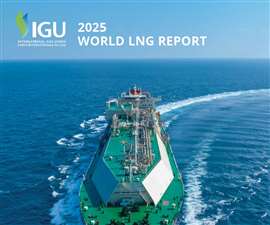Qatar holds firm in global LNG rankings despite slight export dip
May 22, 2025
2025 IGU report shows steady Qatari performance as Asia drives LNG demand shift

Qatar retained its position as the world’s third-largest exporter of liquefied natural gas (LNG) in 2024, despite a modest year-on-year decline in export volume, according to the 2025 World LNG Report published by the International Gas Union (IGU).
Qatar exported 77.2 million tonnes (MT) of LNG last year, down 0.99 MT from 2023. This total represented 18.8% of global LNG exports, trailing only the United States (88.4 MT) and Australia (81.0 MT). The dip placed Qatar among a small group of exporting countries—alongside Egypt and Algeria—that recorded export declines in 2024.
The report confirms that global LNG trade expanded by 2.4% in 2024, reaching 411.24 MT. Trade flows connected 22 exporting markets with 48 importing markets, marking another year of structural growth for the sector. However, the report also noted that only 14.8 MTPA of new liquefaction capacity reached final investment decision (FID), the lowest total since 2020—a sign of lingering caution amid geopolitical, regulatory, and cost uncertainties.
Asia reclaims demand leadership
The report highlighted a major shift in global LNG flows from Europe to Asia. While European imports fell by 21.2 MT to 100.07 MT—driven by high inventory levels, steady pipeline supply, and lower demand—Asian markets surged. Asia’s net imports climbed 12.5 MT year-on-year to 117.97 MT, driven by heatwaves and greater reliance on gas-fired power. Asia Pacific imports rose by 9.8 MT to 165.1 MT, cementing the region’s dominance as the largest global LNG consumer.
China remained the top LNG importer, with imports rising by 7.5 MT to 78.6 MT. India posted a 4.2 MT increase, reaching 26.1 MT—representing a 19.1% year-on-year jump. Japan and South Korea also recorded moderate gains. Collectively, China, Japan, and South Korea accounted for nearly half of global LNG imports in 2024.
Liquefaction capacity grows, but project delays loom
Globally, LNG liquefaction capacity increased by 6.5 MTPA in 2024, reaching a total of 494.4 MTPA. However, project momentum slowed. The year saw only 14.8 MTPA of new capacity sanctioned, a steep drop from the 58.8 MTPA greenlighted in 2023. The report attributes the slowdown to inflation, regulatory delays, and geopolitical risks. Nonetheless, the emergence of new exporters such as Mexico and Congo—both debuting floating LNG (FLNG) projects—underscored the sector’s adaptability.
Qatar’s nameplate liquefaction capacity stood at 77.1 MTPA by the end of 2024. The report also confirms that Qatar’s expansion plans include the integration of carbon capture and storage (CCS) technology, with 7 MTPA of CCS capacity identified as part of its upcoming LNG projects. This places Qatar among the leaders in emissions-reduction initiatives within the LNG value chain.
Market outlook remains mixed
According to IGU Secretary General Menelaos Ydreos, 2024 was a “vibrant year for the LNG sector’s rapid evolution,” but he cautioned that market stability “remains precarious” due to ongoing risks tied to geopolitics, trade, and regulatory changes. The report further notes that heightened scrutiny of methane emissions—particularly from the EU, Japan, and South Korea—is adding new compliance obligations for LNG exporters, including Qatar.
While Qatar’s exports remained flat, its position in the global LNG marketplace appears stable. With new liquefaction trains under construction and emissions-focused upgrades underway, the country continues to position itself for the next wave of demand—especially as Asia’s appetite for gas shows no signs of slowing.
MAGAZINE
NEWSLETTER

CONNECT WITH THE TEAM








